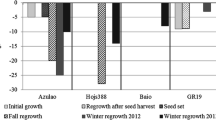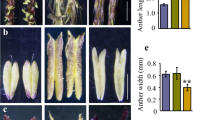Summary
Cajanus platycarpus a wild species of pigeonpea incompatible with the cultigen has many desirable characters important for the improvement of cultivated pigeonpea. In the present study, barriers to hybridization were studied and were identified as post-zygotic. Efficient embryo rescue techniques were developed. As a result, hybrids were produced. Morphological and cytological studies as well as esterase isozyme band pattern confirmed the hybrid nature of the plants. The F1 hybrids were completely pollen sterile. Meiotic studies were carried out to check for the cause of pollen sterility.
Similar content being viewed by others
Abbreviations
- MS:
-
Murashige & Skoog's (1962) medium
- BAP:
-
6-Benzylaminopurine
- IBA:
-
Indole-3-butyric Acid
- NAA:
-
α Naphthaleneacetic Acid
References
Ariyanayagam, R.P. & J.A. Spence, 1978. A possible gene source for early, day length neutral pigeonpeaCajanus cajan (L.) Millsp. Euphytica 27: 505–509.
Dundas, I.S., 1985. Studies into overcoming some crossability barriers involving pigeonpea (Cajanus cajan (L.) Millsp.) and relatedAtylosia species. Post-doctoral Internship Report. Legumes Program, International Crops Research Institute for the Semi-Arid Tropics (ICRISAT). Patancheru, India.
Kumar, P.S., 1985. Crossability genome relationships and inheritance studies in intergeneric hybrids of pigeonpea. Ph.D. Thesis, University of Hyderabad, Ipdia.
Maesen, L.J.G. van der, 1990. Pigeonpea: Origin, History, Evolution and Taxonomy. In: Y.L. Nene, S.D. Hall & V.K. Sheila (Eds) The pigeonpea. Wallingford, Oxen, U.K. CAB international: 15–46.
Nalini Mallikarjuna & D.C. Sastri, 1985.In vitro culture of ovule and embryos from some incompatible interspecific cross in the genusArchis L. Proc. of International Workshop on Cytogenetics ofArachis. ICRISAT Patancheru, P.O. 502 324, A.P., India, pp. 153–158.
Pundir, R.P.S. & R.B. Singh, 1987. Possibility of genetic improvement of pigeonpea (Cajanus cajan (L.) Millsp.) utilizing wild genes sources. Euphytica 36: 33–37.
Reddy, R.J., 1973. Inter-relationship ofCajanus andAtylosia species as revealed by hybridization and pachytene analysis. Ph.D. Thesis, Indian Institute of Technology, Kharaqpur, India.
Remanandan, P., 1990. Pigeonpea: Genetic Resources. In: Y.L. Nene, S.D. Hall & V.K. Sheila (Eds) Wallingford, Oxen, U.K. CAB International: 89–116.
Saxena, K.B., R.V. Kumar, D.G. Faris & L. Singh, 1987. Breeding for special traits. Report of work 1984–86. Pigeonpea Breeding Progress Report 9: 36–89. ICRISAT India.
Scandalios, J.G., 1969. Genetic control of multiple molecular forms of enzymes in plants. A review. Biochem. Genet. 3: 37–79.
Shivanna, K.R. & D.C. Sastri, 1981. Stigma-surface esterase activity and receptivity in some taxa characterized by wet stigmas. Ann. Bot. 47: 53–64.
Singh, A.K. & J.P. Moss, 1982. Utilization of wild relatives in genetic improvement ofArachis hypogaea L. 2. Chromosome complements of species ofSection Arachis. Theor. Appl. Genet. 61: 305–314.
Subbarao, G.V., 1988. Salinity tolerance in pigeonpea (Cajanus cajan (L.) Millsp.) and its wild relatives. Ph.D. Thesis. Indian Institute of Technology. Kharagpur, India.
Author information
Authors and Affiliations
Rights and permissions
About this article
Cite this article
Mallikarjuna, N., Moss, J.P. Production of hybrids betweenCajanus platycarpus andCajanus cajan . Euphytica 83, 43–46 (1995). https://doi.org/10.1007/BF01677859
Received:
Accepted:
Issue Date:
DOI: https://doi.org/10.1007/BF01677859




